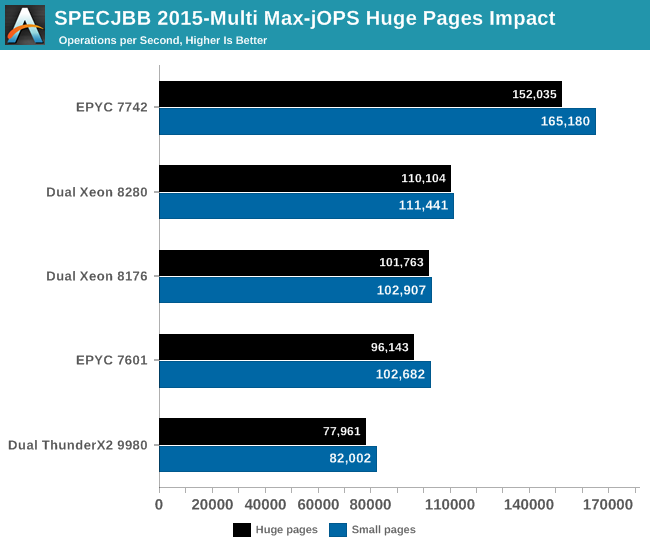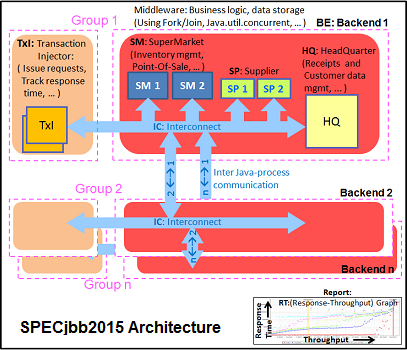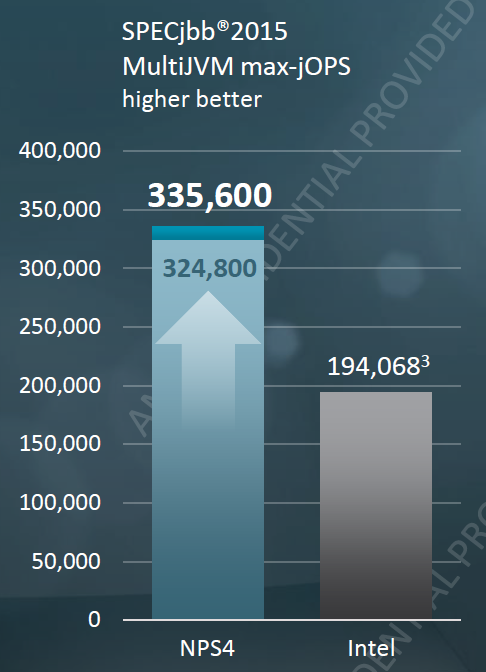AMD Rome Second Generation EPYC Review: 2x 64-core Benchmarked
by Johan De Gelas on August 7, 2019 7:00 PM ESTJava Performance
The SPECjbb 2015 benchmark has 'a usage model based on a world-wide supermarket company with an IT infrastructure that handles a mix of point-of-sale requests, online purchases, and data-mining operations'. It uses the latest Java 7 features and makes use of XML, compressed communication, and messaging with security.
We test SPECjbb with four groups of transaction injectors and backends. The reason why we use the "Multi JVM" test is that it is more realistic: multiple VMs on a server is a very common practice.
The Java version was OpenJDK 1.8.0_222. We used the older JDK 8 as the most recent JDK 11 has removed some deprecated JAVA EE modules that SPECJBB 1.01 needs. We applied relatively basic tuning to mimic real-world use, while aiming to fit everything inside a server with 128 GB of RAM:
We tested with huge pages on and off.
The graph below shows the maximum throughput numbers for our MultiJVM SPECJbb test. Since the test is almost identical to the one that we have used in our ThunderX2 review (JDK8 1.8.0_166), we also include Cavium's server CPU.
Ultimately we publish these numbers with a caveat: you should not compare this with the official published SPECJBB2015 numbers, because we run our test slightly differently to the official run specifications. We believe our numbers make as much sense (and maybe more) as most professionals users will not go for the last drop of performance. Using these ultra optimized settings can result in unrepeateable and hard to debug inconsistent errors - at best they will result in subpar performance as they are so very specific to SPECJBB. It is simply not worth it, a professional will stick with basic and reliable optimization in the real non-HPC world. In the HPC world, you simply rerun your job in case of an error. But in the rest of the enterprise world you just made a lot users very unhappy and created a lot of work for (hopefully) well paid employees.

The EPYC 7742 performance is excellent, outperforming the best available Intel Xeon by 48%.
Notice that the EPYC CPU performs better with small pages (4 KB) than with large ones (2 MB). AMD's small pages TLB are massive and as result page table walks (PTW) are seldom with large pages. If the number of PTW is already very low, you can not get much benefit from increasing the page size.
What about Cavium? Well, the 32-core ThunderX2 was baked with a 16 nm process technology. So do not discount them - Cavium has a unique opportunity as they move the the ThunderX3 to 7 nm FFN TSMC too.
To be fair to AMD, we can improve performance even higher by using numactl and binding the JVM to certain CPUs. However, you rarely want to that, and happily trade that extra performance for the flexibility of being able to start new JVMs when you need them and let the server deal with it. That is why you buy those servers with massive core counts. We are in the world of micro services, docker containers, not in the early years of 21st century.
Ok, what if you do that anyway? AMD offered some numbers, while comparing them to the officialy published SPEJBB numbers of Lenovo ThinkSystem SR650 (Dual Intel 8280).
AMD achieves 335600 by using 4 JVM per node, binding them to "virtual NUMA nodes".
Just like Intel, AMD uses the Oracle JDK, but there is more to these record breaking numbers. A few tricks that only benchmarking people can use to boost SPECJBB:
- Disabling p-states and setting the OS to maximum performance (instead of balanced)
- Disabling memory protection (patrol scrub)
- Using older garbage collector because they happen to better at Specjbb
- Non-default kernel settings
- Aggressive java optimizations
- Disabling JVM statistics and monitoring
- ...
In summary, we don't think that it is wise to mimic these settings, but let us say that AMD's new EPYC 7742 is anywhere between 48 and 72% faster. And in both cases, that is significant!












180 Comments
View All Comments
nathanddrews - Wednesday, August 7, 2019 - link
Binned for OC? We'll find out soon enough!DigitalFreak - Thursday, August 8, 2019 - link
At this point it looks like all TR will get your is "official" ECC support and more PCIe lanes. Maybe cheaper motherboards than EPYC.willis936 - Thursday, August 8, 2019 - link
Half the memory lanes (this is a big one), half the pcie lanes, max of 1 socket per mobo. Those are important features for datacenter customers and their absence from threadripper makes threadripper less desirable than epyc in the datacenter.rocky12345 - Thursday, August 8, 2019 - link
Yes but Threadripper is made for high end desktops for video editing etc etc and some gaming. I do not see the big data center guys going after TR all that much. Yes you may see some of the TR go there but that is not what TR is made for that is why we have EPYC & XEON CPU's.I do have to agree though where some said where does TR fit in price wise since we are going to have a 16/32 main stream desktop CPU shortly from AMD. I do also think this time around the 32/64 3990 TR will be 10x better than the older 2990 TR just from the memory controller not being in each CPU complex and in the 2990x because of bandwidth and latency from the memory performance really suffered when all cores were being used. On the 3990x (or whatever it will be called) this should not be an issue. If AMD is smart they will not release a 64/128 3000 series TR since it would have to be priced to far out of reach for even the most techy guy with money and the only ones that would have them would be review sites and YT reviewers and that would be only because them got them sent for free for reviews. 32/64 and the better memory performance as a whole for the new chips would be more than enough to make the 32/64 TR 3990x an instant success. Just my opinion of coarse and AMD will probably do something stupid and release a higher core count TR series CPU that next to no one will be able to afford just to be able to say hey we got the best high end CPU on the planet but to bad no one is gonna buy them because the price is to high but we have the best so who cares.
rocky12345 - Thursday, August 8, 2019 - link
Oops dammit forgot to make paragraph's did not mean to have it all bunched up like that.Mark Rose - Friday, August 9, 2019 - link
Why wouldn't they release a 64 core Threadripper? Assuming they double the price of the 32 core, it would be $3400. That's affordable to a lot of people working in tech, and should be affordable to just about any business that has employees waiting on their 32 core Threadripper. AMD would sell a ton.That being said, I wouldn't personally buy one as I don't have a need. I'd be more likely buy a 16 core 3000 series Threadripper myself.
Manch - Friday, August 9, 2019 - link
Higher Clockssor - Wednesday, August 7, 2019 - link
It will be a feature/packaging thing. The motherboards would be TR4 and feature enthusiast features, overclocked memory, etc, not highly reliable server oriented boards. The processors themselves might be fairly comparable to their EPYC counterparts, as some Xeons were occasionally comparable to their desktop ones.close - Thursday, August 8, 2019 - link
TR was supposed to be a stopgap measure until the consume Ryzen range stretched high enough and the server EPYC range stretched low enough. I guess there is a place for further differentiation especially in terms of the platform (motherboard) used, where you have server like CPU on a more consumer like MB to create basically a workstation. Maybe OC will also fit in here.Death666Angel - Friday, August 9, 2019 - link
"TR was supposed to be a stopgap measure" where can I see AMD stating that? Considering Intel has fared pretty well with the consumer/HEDT/server differentiation, I don't think AMD needs to axe TR. I don't see them giving us EPYC with OC functions and 8 memory channles seems overkill for 16 or 32 desktop cores. I also haven't seen a statement to the effect you claim, so I highly doubt it at the moment.